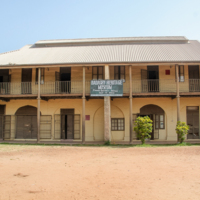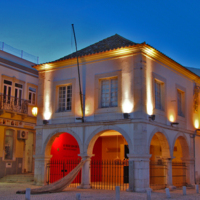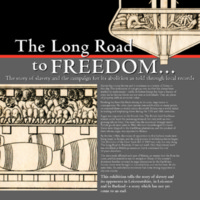
Badagry Heritage Museum
The Badagry Heritage Museum is housed in the former district officer’s office that was constructed in 1863. The museum attempts to highlight the injustice and horror of the transatlantic slave trade, whilst also exhibiting the rich histories and cultures of Africa. There is a specific focus on the heritage of pre and post-transatlantic slave trade in Badagry. The museum consists of eight galleries each dealing with particular themes relating to local heritage and the transatlantic slave trade. Guided tours are available. The museum is managed by the Nigerian Cultural Commission.Each of eight galleries are named after a part of the transatlantic slave trade. The first, the 'Introductory Gallery', focuses on the founding and early history of Badagry. The next five galleries all deal specifically with distinct phases of the slave trade, from capture, transportation, material culture, resistance, and industry. In these galleries are objects that illustrate the brutal nature of enslavement, including shackles and manacles, as well as replicas of slave ships. The seventh gallery examines the forced integration of the enslaved into the countries they were transported to, featuring videos of reconstructed slave auctions. Finally, the last gallery explores abolition movements and the persistence of slavery even after its legal end. The museum has attempted to incoporate the voices of local people within the displays, as well as depicting the significance they place on certain cultural and historical items within the museum. In addition to the historical collections, there are also some examples of contemporary art throughout, showing modern reflections on the systems of enslavement.

Mercado de Escravos
The Mercado de Escravos (or Slave Market Museum) is situated in the center of Lagos on the site of a fifteenth-century slave market, believed to have been the first in Europe. The museum building itself was built in the seventeenth century on the remains of the market, first as the Royal Overseer's Office, and then as the Customs House from 1755. The museum seeks to highlight the history of Portuguese involvement in the enslavement of African people.
The opening displays in the museum provide the visitor with detail about the process of enslaved Africans being transported from Africa to Portugal, and how they were then integrated into Portuguese society. There is also a panel which provides information linking this to the slave trade in Brazil, which was then a Portuguese colony.
On the second floor of the museum, there are further displays about the slave trade. The collections include books, artefacts, archival material and pieces of art (both contemporary and historic). There are tablets available so that visitors can view more of the museum's collections that are not out on display.
The Slave Market also provides visitors with information about archaeological excavations on the medieval rubbish tip of Lagos, which have led to the discovery of skeletons thought to belong to enslaved Africans.

The Long Road to Freedom
As made clear by The Long Road to Freedom exhibition in 2007, the Record Office for Leicestershire, Leicester & Rutland contains a significant collection of documents which reveal local connections with the slave trade, and with those who campaigned for abolition. Several prominent local families owned slaves on plantations in the Caribbean and on the north coast of South America. Leading Leicester abolitionists, Elizabeth Heyrick and Susanna Watts, orchestrated a vigorous anti-slavery campaign in Leicester, including a boycott on sugar. Local landowner, Thomas Babington of Rothley Temple, was a friend of William Wilberforce and hosted meetings of anti-slavery campaigners at his home. The exhibition also highlighted a unique collection of mid-19th century papers which provide access to the voices of the enslaved in a slave court in Lagos, West Africa. It also told the stories of two former slaves, Rasselas Morjan and Edward Juba, who came to Leicestershire with their owners. This exhibition toured to various venues in the region, including Abbey Pumping Station, where it coincided with family activities focused on the work of Elizabeth Heyrick.